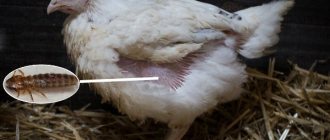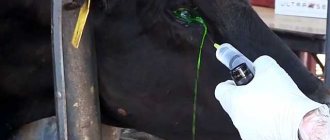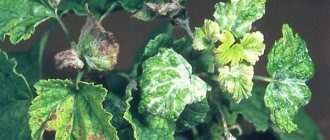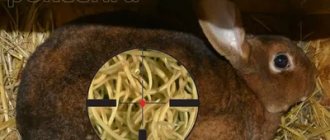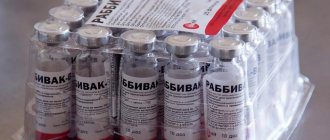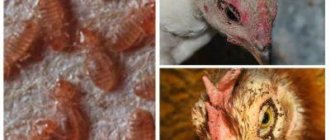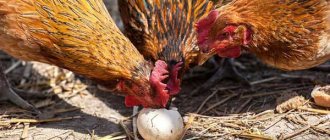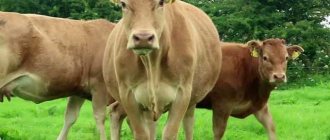Manifestations of myxomatosis in rabbits and incubation period
Specific symptoms depend on the form of myxomatosis. Common manifestations include:
- Passivity, lethargy, sometimes lethargy.
- Lack of appetite.
- Signs of conjunctivitis.
- Dullness of fur, appearance of bald spots.
- Swelling of the lips, ears, nose, eyelids, genitals.
- If the condition worsens, there is immobility or coma.
- Drooping ears (except for fold-eared breeds).
- Skin rashes.
- Sometimes myxomatosis can be accompanied by pneumonia.
The final diagnosis is made based on epidemiological data, characteristic symptoms, autopsy results and laboratory tests. The pathology is differentiated from smallpox, infectious fibromatosis, staphylococcosis, and wandering pyaemia.
| Schematic route of virus infection | ||||
| Virus entering the bloodstream from an insect bite→ | The incubation period of the disease lasts from 2 days to 3 weeks (depending on the virulence of the pathogen and the immunity of the animal) → | Spread of the pathogen through the lymph to the lymph nodes throughout the body without manifestations (about 2 days)→ | Virus reproduction lasts up to 48 hours (capillary permeability decreases, edema develops, temperature rises to 42C)→ | → On the third day from mass viral reproduction - copious discharge from the nose and eyes containing the pathogen (conjunctivitis). → On day 4 – pathological changes in the skin (redness, myxoma tumors). → On the 5th day – dysfunction of the external genitalia. |
| The largest amount of the pathogen is determined at autopsy in myxomas (bumps on the skin), lymph nodes, lungs, spleen, blood, and internal organs of rabbits. After suffering from the disease, rabbits develop lifelong immunity, but at the same time they remain a long-term infectious carrier (up to 6 months). | ||||
Activities in the infected area
According to reviews, compliance with quarantine is very important. Such activities in an infected area include:
- stopping the import and export of animals from the populated area;
- It is forbidden to allow other people into the territory where rabbits are located, only the owners;
- within the infected area, it is prohibited to regroup rabbits, as well as exchange them between neighboring farms.
To prevent the development of the disease, these measures are considered mandatory.
Myxomatosis in rabbits: types
| Form of myxomatosis | Specific symptoms | Photo |
| Classic (acute, edematous) Lasts from 4 to 10 days, mortality reaches 100%. | • Gelatinous swelling, red bumps, spots on the skin, swelling of the subcutaneous tissue. • Swollen head. • Swollen drooping ears. • Purulent conjunctivitis with swelling and adhesiveness of the eyelids. • A sharp rise in temperature to 42°C (one day before the appearance of the main symptoms). • Formation of white tumors with serous fluid. • Enlarged lymph nodes, spleen, kidneys. • Pulmonary edema with signs of inflammation (hoarseness, difficulty breathing). • Mucus discharge from the nose. | |
| Nodular (nodular, subacute) Lasts 1.5 months, from 20% to 70% of the population survives. It is considered the mildest form of the disease. | • Formation of fibrous nodules-papules (back, nose, limbs, eyes) with subsequent outflow of pus from them. • Stable temperature at 38.5-39.5°C. • Conjunctivitis. • Rhinitis. | |
| The atypical form develops due to mutation of the virus. | There are atypical nodular, respiratory, abortive myxomatosis in rabbits and a form of the disease with erased symptoms. Depending on the modified strain, runny nose, lacrimation, cough, hemorrhages in the lungs, focal bronchopneumonia, swollen lymph nodes, and miscarriages may occur. At autopsy, gelatinous infiltrates are found under the upper layer of the epidermis. |
How does myxomatosis manifest?
As a rule, several days pass before the first signs of a defect appear. In the vast majority, mycosmatosis does not manifest itself during the first six days. And after 11 days its signs become pronounced.
Myxomatosis in rabbits is practically invisible for the first few days. Its development can only be revealed by careful examination of the eared animal. If your pet is attacked by this defect, then red spots will be barely visible on its skin.
The next signal about the development of this disease in rabbits is a high temperature, which often reaches up to 41 °C and then drops to its normal levels. Then, as the defect progresses, conjunctivitis develops in rabbits.
Pets' eyes become very watery and inflamed, and clots of purulent discharge begin to appear on them. The next sign of the development of myxomatosis: manifests itself in the form of tumor formation.
At the initial stage, such neoplasms are practically invisible, and if you manage to feel them, they are absolutely insignificant and resemble millet grains.
As the disease progresses, such neoplasms become the size of a quail egg.
Another dangerous sign of this disease is swelling. It appears in different areas of the rabbit's head. Swelling can form in the following areas:
- ear area;
- in places where the animal’s eyelids and ears are located;
- less often, but swelling can occur in the genital area;
- on the anus.
Visually, this symptom manifests itself in the form of a greatly enlarged head of the long-eared rabbit, while its ears, one might say, wither and the rabbit is not able to breathe normally due to the fact that the mouth opening is inflamed. Purulent accumulations in the form of mucus begin to flow from the mouth.
Important: This defect progresses over 11 days. Then, the animal whose immune system is weakened dies. And stronger rabbits can recover and be completely cured of such a defect.
Causes of miscomatosis and how infection occurs
The causative agent of the infection is Myxoma leporipoxvirus, a DNA-containing virus from the genus Leporipoxvirus of the Poxviridae family, which gives the pathology its name.
The first documentary descriptions of the virus date back to 1898. The documents mention that it spread from Uruguay and Brazil, where its carriers then lived - a local species of wild rabbits. It is worth noting that the eared animals themselves did not show clinical symptoms and lived quite normally with the infection inside.
It so happened that the animals were transported first to Australia and then to European open spaces for the purpose of distribution. A new viral strain from infectious long-eared animals quickly inseminates local species of lagomorphs and is practically out of control. In a short period of time, the disease has spread to all continents, and the virus has mutated into several varieties and continues to affect eared populations around the world.
The virus dies from exposure to ether, formalin, and alkaline solutions. Inactivation of the pathogen occurs when heated to +55°C for half an hour.
But at temperatures from 8 to 15°C, the virus persists for up to 90 days on surfaces, up to a week in the corpse of an animal, and up to a year in dried skins.
Peak incidence is August-September. It is possible that infection can also occur at other times of the year.
Video Myxomatosis! What is it, where does it come from, how to fight it!
How is myxomatosis transmitted in rabbits?
The route of transmission of the disease is contact - through the paws of blood-sucking insects (mosquitoes, flies, bedbugs, fleas), in whose bodies the pathogen exists for up to six months, or with the claws of birds. Infection also occurs by airborne droplets through close contact with sick eared animals (at the stage of discharge from the nose and eyes).
At-risk groups
All domestic rabbits and their wild relatives are susceptible to myxomatosis, regardless of age. The disease is fleeting (adults are sick for up to 6 weeks, young animals - up to 14 days).
Is there a risk of a person getting sick?
A person is not susceptible to the virus, so even if he comes into contact with sick animals, he will not get sick.
Features of the virus
Myxomatosis was first described at the end of the 19th century. The disease was observed in Uruguay in rabbits imported there from Europe. The spread of the virus to other continents began half a century later. It was brought to Australia specifically for the purpose of exterminating and limiting the uncontrolled growth of the rabbit population, which had no natural enemies in nature and caused huge losses to farmers. In the 80s of the last century, the virus reached European countries, including the USSR - outbreaks of the disease were noted in Russia, Belarus, and Ukraine.
The causative agent of myxomatosis is highly resistant in the external environment: it can survive in animal corpses for a week, in skins dried at a temperature of 70 ℃ for several hours, and at 20 ℃ for several months. The frozen virus remains active for two or more years. This is why frozen meat and uncured skins obtained from infected animals pose a great danger to other rabbits.
The causative agent of myxomatosis is similar to the smallpox virus, affects exclusively rabbits and threatens the loss of the entire livestock
The virus is also resistant to a wide pH range. It can be destroyed by heating at temperatures above 60 ℃ for an hour. A 3% solution of formaldehyde and caustic alkali, trypsin, ether and formalin are capable of inactivating the pathogen.
Distribution routes
Today, myxomatosis is considered a major infectious disease that has a direct impact on the rabbit population.
The virus is spread mainly by blood-sucking parasites : mosquitoes, lice, fleas. It is localized in the salivary glands of insects, where it can remain active for a long time (a rabbit flea remains a carrier of infection for more than 100 days, a mosquito for 7 months), and through bites it enters the blood of animals.
The pathogen can be transmitted through direct contact from an infected individual to healthy individuals, through household items, and also by some species of waterfowl.
Wild hares are less susceptible to the disease, but are often carriers of myxomatosis in nature
All breeds of rabbits are susceptible to the virus . In affected individuals it is found in the blood, skin, subcutaneous tissue, and parenchymal organs.
Treatment of rabbits for myxomatosis
| Therapeutic measures for myxomatosis | ||
| Acute form | Nodular form | Atypical course |
| There is no treatment. It is recommended to send all sick animals to slaughter followed by destruction of the carcasses. | • Injection antibiotic therapy. • Antiseptic treatment of skin lesions with iodine solution until they are completely healed. • Treatment and eye drops (okomistin, tobradex, ofloxacin). • Nasal rinsing (saline, aquamaris). • Administration of B vitamins, immunostimulants (Gamavit, fosprenil). | Symptomatic treatment. |
Using antibiotics
Antibacterial drugs show their effectiveness in the treatment of subacute forms of the disease, as well as when indicated for atypical forms. But it is worth noting that they are needed only in case of complications, when bacterial flora joins against the background of a viral infection. Antibiotics do not act directly on the myxomatosis virus.
Among the drugs frequently used by veterinarians are Baytril, amoxicillin, benzylpenicillin, and bicillin.
Folk remedies
Traditional methods at home cannot completely cope with the infection. But in some cases, they ease the course, help fight skin rashes, heal exudates, and increase the body’s resistance.
Experienced rabbit breeders recommend:
- Keep the sick animal warm.
- Avoid fasting and refusing to drink (if necessary, forcefully pour in ground liquid food or water using a syringe).
- Feed your pets with green parsley, spruce branches, and raspberry leaves.
- Drip aromatic essential oils (eucalyptus, tea tree) near the animal.
- Lubricate the affected areas with overcooked vegetable oil.
Effective treatment methods
The treatment regimen for viral pathology depends on the results of the examination, diagnosis, and the epizootological situation in the region. First of all, the form of the disease is determined. It is pointless to treat the classic one; once it is diagnosed, infected individuals, their bedding, feed, feeders, drinking bowls and other equipment must be destroyed. The cells are completely disinfected with firing and treatment with chemical compounds.
Therapy for nodular myxomatosis is carried out at its initial stages in order to strengthen the immune system and eliminate symptoms. It includes the following methods and procedures:
- Subcutaneous injections of Gamavit 2 ml/kg body weight or Fosprenil 1 ml are given daily at the withers until complete recovery. Serve to stimulate nonspecific resistance, therapy of viral diseases and immunomodulation. When dehydrated, mix with Ringer's solution.
- Antibiotic drugs are injected into the muscle of the hind paw. Bicillin is a natural penicillin and is administered 1 ml every 3-4 days. Benzylpenicillin sodium salt is administered 2 times a day for 5 days. They need to be dissolved immediately before use with sodium chloride or novocaine 0.25-0.5%.
- Instead of drinking, dilute Baytril 1 ml/kg, the dose is 5 ml of 10% of the drug per 10 liters of water. It has an antibacterial and antimycoplasma effect, suppresses the work of pathogenic bacteria.
- To eliminate conjunctivitis, the eyes are washed with saline solution, washing away the purulent discharge. They are then treated with drops and ointments such as Ofloxacin containing antibiotics.
- To reduce swelling of the nasopharynx, facilitate breathing and improve the functioning of the respiratory system, anti-rhinitis medications are instilled into the nose. Aquamaris drops are recommended for rabbits.
- Open wounds, bumps, nodules, necrosis and other skin lesions are treated with an alcoholic iodine solution or Fukortsin 2-3 times a day.
These and other drugs should be used according to the instructions and in accordance with the recommendations of specialists. In addition, there are the following traditional methods of therapy:
- unrefined sunflower oil, overcooked for 15-20 minutes in a hot frying pan, is suitable for lubricating affected areas of the skin;
- camel thorn infusion is injected into the shin in a dosage of no more than 2 ml for small animals or 5 ml for adults;
- Leave urine in the sun for 2-4 hours to lubricate wounds and necrosis to heal them and repel insects.
To speed up the recovery of the infected pet, you should provide comfortable housing, warmth and good nutrition. And after recovery, keep in quarantine for at least 2-3 months.
Quarantine measures
Once the diagnosis is confirmed, the farm and settlement are declared unfavorable for myxomatosis. The enterprise is quarantined for 14 days. Measures are being taken to prevent and eliminate the disease.
During quarantine, the rabbit farm is completely isolated (contacts of rabbits with livestock or wild animals are excluded, auto communications with other enterprises, and removal of equipment outside the farm are prohibited).
Carried out:
- Slaughter of sick animals followed by burning of the carcasses.
- All entrances to the farm are equipped with disinfection barriers; mats soaked with a 3% caustic soda solution are placed at the entrance.
- All premises are thoroughly disinfested and disinfected.
- Service personnel are allowed to work only in a change of clothes and shoes (old ones are burned), which are disinfected daily in a formalin-vapor chamber.
- To prevent the spread of the disease, all healthy rabbits are unscheduled vaccinated against myxomatosis.
| Prevention of myxomatosis in rabbits | |
| Carrying out veterinary and sanitary measures | Specific vaccination |
| Imposing restrictions on the movement of animals. Arrangement of protective devices against insects. Quarantine for all newly arrived animals. Balanced diet. Periodic examination of animals to identify individuals with signs of disease. Isolation of sick animals. Treatment of feces and rabbit corpses with disinfectants. Disinfestation, disinfestation. Regular cleaning of rabbit hutches and premises. Periodic disinfection of cells, premises, equipment. | Vaccination against myxomatosis is in accordance with the established vaccination calendar. Vaccinate only a completely healthy rabbit! 1 vaccine – carried out in the spring, the rabbit is at least 4 weeks old. 2nd vaccine – 4 weeks after the first. 3rd vaccine – 5-6 months after the primary vaccination. If all vaccinations are successful: vaccination is carried out 2 times a year - in early spring and early autumn. |
How to treat myxomatosis at home
So how to treat myxomatosis in rabbits at home? Most doctors are confident that the treatment of this pathology has some difficulties and does not always lead to a positive result.
However, if you start treating myxomatosis in rabbits from the first symptoms, you can quickly eliminate all manifestations of this pathology. Moreover, now there are various options that can quickly heal animals.
Features of vaccination against myxomatosis
Vaccination cannot completely protect rabbits from myxomatosis, but it greatly facilitates the course of the disease and prevents the occurrence of this pathology in the future. This therapy will also increase the survival rate of animals in the future.
If vaccination is carried out, then when infected with myxomatosis, swelling and nodules will appear in rabbits. Over time, all these symptoms will disappear on their own, without the use of medical therapy. Validity period: 9 months.
Features of vaccination:
- The first vaccination of a rabbit should be done no earlier than six weeks of age, about a week after weaning the rabbit;
- from two months the animals are given revaccination;
- You need to get vaccinated twice a year - in March and September;
- The vaccine should be administered using sterilized needles and syringes. All instruments for this procedure must be boiled for a quarter of an hour;
- It is advisable to use a separate needle for each animal. You should not vaccinate all animals with the same needle, because you can get infected;
- after administering the vaccine, it is recommended to thoroughly treat the vaccination area with an alcohol solution;
- It is further recommended that rabbits be monitored regularly for 22 days.
The vaccine is administered subcutaneously, intramuscularly and intradermally.
For subcutaneous use, the vaccine is diluted per 1 dose with 0.5 ml of solvent and 0.5 ml is injected into the withers area if subcutaneously, and into the thigh area if intramuscularly.
For intradermal administration, it is necessary to use 0.2 ml of solvent per dose of the vaccine. The medicine should be injected into the area of the ears or caudal mirror in a dose of 0.2 ml.
It is worth noting! Rabbits under 6 weeks of age cannot be vaccinated. Vaccination should only be done on healthy animals, because vaccinating sick pets is a futile exercise that does not have the desired effect and can, on the contrary, provoke infection.
After vaccination, quarantine must be observed for a maximum of two weeks. The development of lasting immunity begins from the 3rd day.
Use of antibiotics
Myxomatosis in rabbits can be treated with antibiotics. But antibiotics and immunomodulators can only be used at an early stage of the disease. To treat wounds with an open structure, you can use an iodine solution with an alcohol base. You can also use ointments that contain an antibiotic.
When the first symptoms of the disease appear, you must call a veterinarian. He will carefully examine individuals with suspected myxomatosis and prescribe the following drugs for treatment:
- Fosprenil. This is a good antiviral drug that should be used in injection form. The medication must be taken every day;
- Gamavit. This product is a complex of B vitamins, it helps eliminate harmful substances from the animal’s body, and also improves the immune system. It must be used as an injection;
- Baytril, This is an effective medicine that has an effect against a large number of bacteria and harmful organisms. Rabbits must be given this solution to drink. It is given twice a day - morning and evening;
- To eliminate signs of dehydration, it is recommended to give Ringer's solution;
- To reduce swelling and inflammation, drops are used;
- Furacilin has a good effect, Ofloxacin can be instilled into the eyes;
- How to treat bumps and ulcers? For treatments, it is recommended to use an iodine solution with an alcohol base.
Sometimes it is recommended to use Penicillin in the form of injections. However, before starting treatment, it is worth consulting with a veterinarian, since each case is individual and self-medication can only destroy your rabbit.
In addition, it is important that sick rabbits eat well and drink water regularly. If they have no appetite and cannot feed themselves, then they need to be fed through a syringe. At this time, you should give food high in vitamins, for example, you can make fortified pumpkin porridge with pineapple juice.
Pay close attention to your rabbit's eyes. In case of severe tearing, it is necessary to rinse using chamomile-based tinctures; regular tea is also suitable. During this period, the animal requires warmth; for this reason, the temperature in the place where it is kept must be maintained at a temperature of at least 20 degrees Celsius.
Traditional treatment
It is worth remembering that traditional methods will not be able to cope with myxomatosis. Often, even strong antiviral drugs cannot eliminate this pathological process, let alone traditional methods of treatment.
But if there is no veterinary specialist nearby, and you urgently need to take the necessary actions to alleviate the condition, then you can use urine, which can eliminate severe inflammation and swelling. Pour urine into a jar and place it in the sun for about 2-3 hours. After a period of time has passed, the affected areas need to be wiped with this product. Myxomatosis cannot be cured, but until the veterinarian arrives, it will help alleviate the rabbit's condition.
Establishing diagnosis
A preliminary diagnosis is made based on the results of a clinical examination and symptoms of the disease. To make a final diagnosis, you need to consider:
- Epizotological situation in the region (prosperity, presence of disease outbreaks).
- Autopsy results and characteristic symptoms of the disease.
- Results of laboratory diagnostics (in the absence of a characteristic picture of the disease, a bioassay is performed).
It is necessary to differentiate myxomatosis from the following diseases:
- Rabbit pox (autopsy results differ significantly: the subcutaneous tissue is not swollen, but dry, discoloration and flabbiness: heart, liver and spleen).
- Staphylococcal infection, wandering pyaemia, infectious fibromatosis, infectious rhinitis (various pathogens, rate of spread, course features, differences in the clinical picture).
The danger of myxomatosis for humans
Scientists have proven that myxomatosis is not transmitted from rabbits to humans. But the question of whether it is possible to eat the meat of a rabbit with myxomatosis is not so clear-cut. Theoretically, the meat of sick or surviving animals after appropriate heat treatment can be eaten without fear.
But in practice, looking at the disease-damaged appearance and suffering of a sick rabbit, few people will want to feast on its meat. And there is almost no meat in the animal, emaciated from hunger and illness, only skin, muscles and bones.
It’s another matter if the disease is detected at an early stage, when the rabbit is not yet disfigured or dried up from the inside by the disease. In this case, if you do not want to take risks, the animal can not be treated, but slaughtered and skinned. The meat of such a rabbit can be eaten, you just need to first wash it thoroughly and then fry it well.
How is immunity formed?
Animals that survive myxomatosis develop a long-lasting immune response to the disease. Cubs that are born from females who have recovered from the disease become invulnerable to the virus. This is due to the transfer of antibodies from matter. Resistance remains for a month after birth.
Specific prevention is vaccination of livestock. This procedure is carried out at one and a half months of age. The injection is placed subcutaneously in the thigh. After three months, an immune response is formed. Females can be vaccinated regardless of trimester of gestation.
Revaccination is carried out after 9 months. It is imperative to re-vaccinate every 9 months. 5 days after vaccination, immunity begins to actively form. For 3 weeks after vaccination, the condition of the animals should be monitored, and be sure to provide them with the necessary living conditions. If at the time of vaccination myxomatosis develops in the animals’ bodies in a latent form, the rabbits die.
Vaccination is the main measure to prevent the development of myxomatosis. With its help, the fight against the virus among healthy livestock is carried out. But at the same time, you need to remember that even timely vaccinations do not provide a 100% guarantee that animals will not get sick. Vaccination can reduce the risk of developing the disease. If rabbits do get sick, the course of the disease will not be as aggressive, and the chances of recovery increase.
Meat from animals that have recovered from the virus - should we eat it or not?
Many rabbit breeders are concerned about the issue of eating meat from animals that have had a viral infection. Experts do not give a definite answer. Some claim that myxomatosis is harmless to humans. Others are of the opinion that eating the products is dangerous.
You should not eat the meat of dead rabbits, even those who did not have an infection. And if the animal was infected with the virus, then after death it must be burned.
High-quality care for pets, vaccination and timely comprehensive measures to combat myxomatosis will help avoid the death of livestock and obtain a tasty dietary product.
Effective vaccines against the disease
Even timely vaccination cannot fully provide protection against the disease. The injection helps to transfer the virus in a mild form, reducing the rate of relapses. The vaccine increases the body's resistance to myxomatosis, increasing the percentage of surviving rabbits.
The course of the disease in individuals who received the medicine intramuscularly on time is manifested by small swellings and nodules. Symptoms quickly resolve without outside intervention. One injection is enough for 270 days. There are rules for vaccinating rabbits, which involve a number of actions:
- The animal receives its first vaccination at one month of age after weaning from the female rabbit.
- Revaccination is carried out for rabbits that have reached two months after birth.
- The injection is administered twice throughout the year - in mid-March and September.
- The injection is given with a sterile disposable syringe. If the instrument is reusable, boil it for at least 15 minutes.
- It is unacceptable to prick several individuals in a row with a dirty needle to prevent the spread of a viral infection.
- The area around the vaccination is treated with medical alcohol.
- When all animals have received the vaccine, they are monitored for 2-3 weeks.
Vaccination of rabbits
For subcutaneous vaccination, the vaccine and solvent are mixed in equal proportions. Half a milliliter of the drug is injected into the femoral area.
Rabbits under 4 weeks of age are not vaccinated. The vaccine is given to healthy individuals. Vaccination of sick animals is ineffective. After the injection, a two-week quarantine is imposed.
Symptoms of myxomatosis, characteristic of certain types of the disease
Myxomatosis can be of two types:
- In an edematous form.
- In a nodular form.
The first type is a dynamically developing disease that almost always ends in the death of the rabbit. It is believed that the edematous form of myxomatosis cannot be treated .
The disease manifests itself as inflammation of the mucous membrane of the eyes, which develops into conjunctivitis. In this case, crust formation can be observed. The nasal cavity also swells, the animal has difficulty breathing, wheezing comes out of the throat and purulent clots come out. Tumors cover the rabbit's entire body. They are filled with liquid. The animal itself feels very bad - it looks dejected, there is pain and melancholy in its eyes, the animal does not touch food. Ears droop. Literally ten days later the rabbit dies.
As soon as the disease becomes known, the rabbit must be immediately taken away from other animals so that they do not become infected. If he died from myxomatosis, the body should be removed from the nursery. It is advisable to dispose of the remains.
The second type of disease - nodular - is not as dangerous for sick animals as described above. With nodular myxomatosis, many rabbits remain alive (about half of the total, as statistics show) . The disease in this form is well treated.
General description of the disease
Myxomatosis is considered a highly contagious viral disease. It is widespread among both domestic and wild rabbits. The severity of the lesions depends on the pathogenicity of the virus strain, but all of them turn out to be life-threatening for animals. It is resistant to environmental factors, and remains active in the skins of dead rabbits for more than 200 days.
The clinical picture of the disease is the reaction of the rabbit’s body to the entry and reproduction of the virus. The disease is accompanied by the appearance of purulent discharge from the eyes and nose of the animal, increased body temperature and general weakness. In addition, myxomatosis can occur in one of the following forms:
- edematous - a more dangerous option, often ending in the death of the entire population of rabbits;
- nodular - up to 50% of animals can survive an outbreak.
The disease occurs in the form of enzootics or epizootics. Outbreaks of myxomatosis have been reported in Europe, South and North America, and in Australia. The incidence rate increases in the warm season, which is associated with the activity of ticks and blood-sucking insects.
How did the pathogen appear?
This disease was first heard of at the end of the 19th century. The first case was recorded in Uruguay, where the first batch of rabbits was imported from Europe. The natural host for pathogens is the American rabbit. It is grown in North and South America. In these animals, when the virus is activated, a benign disease develops. In European rabbits, the virus provokes the development of a deadly disease. In 1950, the virus began to spread throughout the world.
The causative agent of the disease was discovered in a Uruguayan laboratory. It was found that this is a virus that contains cell DNA. It is very similar in structure to fibromatosis. Those animals that managed to overcome fibromatosis are immune to myxomatosis. If they get sick, they have a mild illness.
The morphological properties of the pathogen resemble those of the vaccinia virus. It is stable in external conditions and remains in the body of a dead animal for 7 days. Therefore, even after the death of rabbits, their skins carry the risk of spreading the virus.
